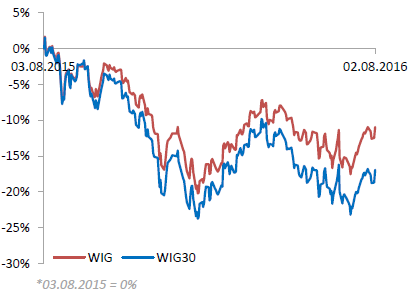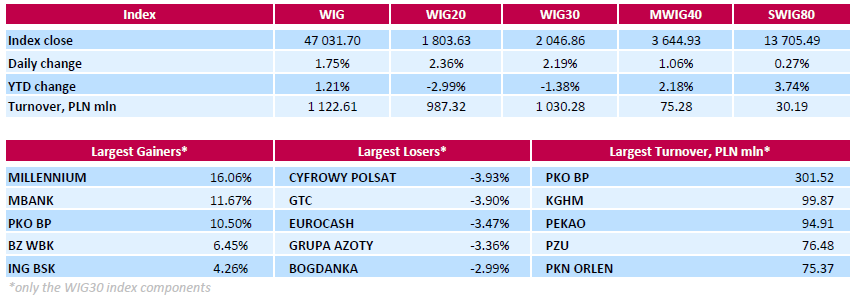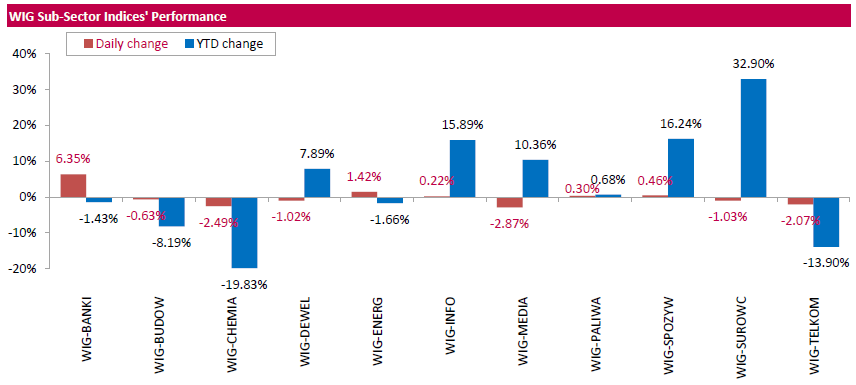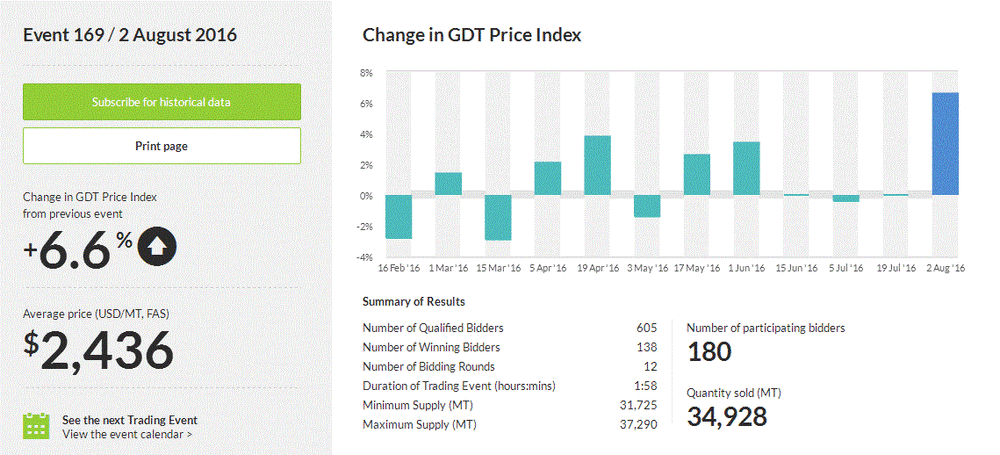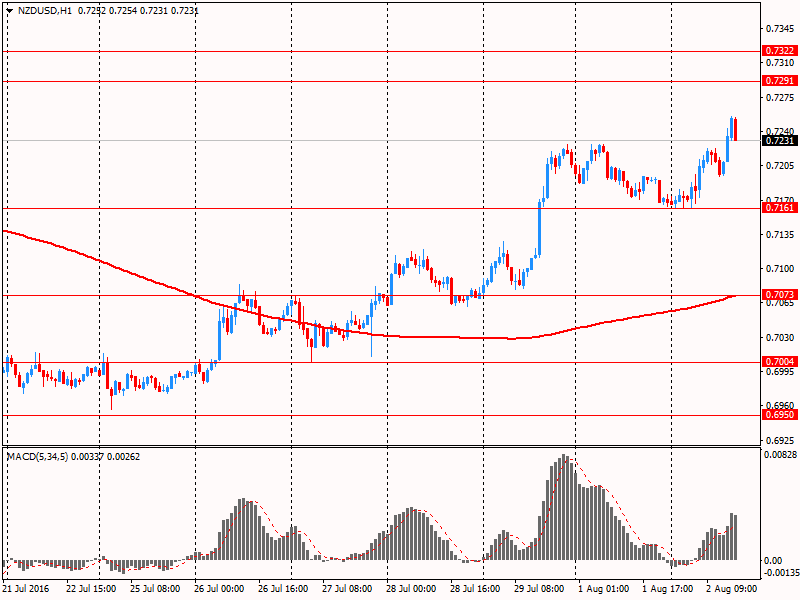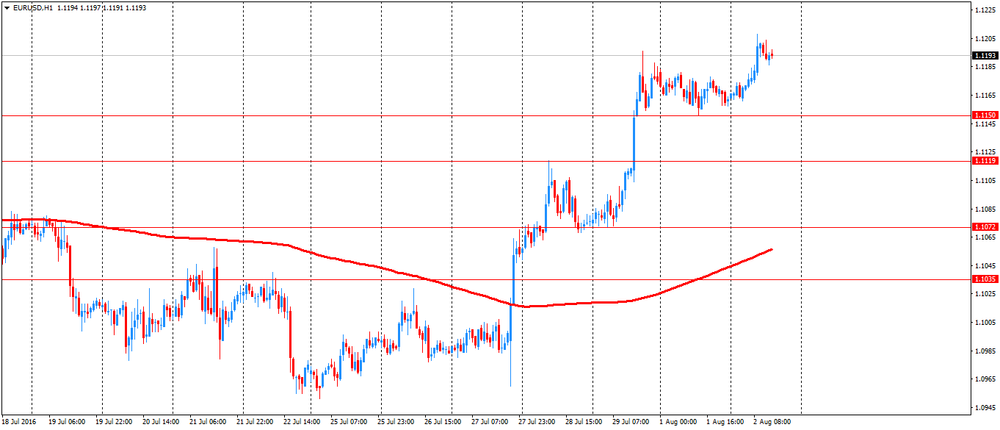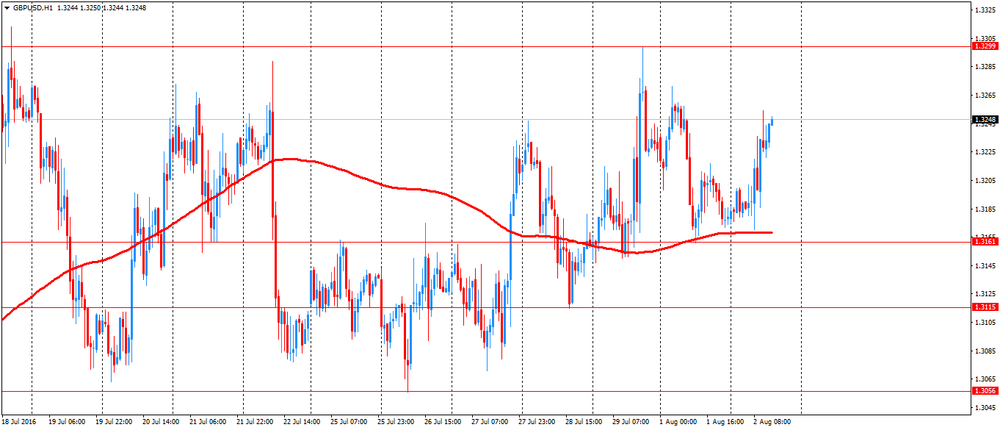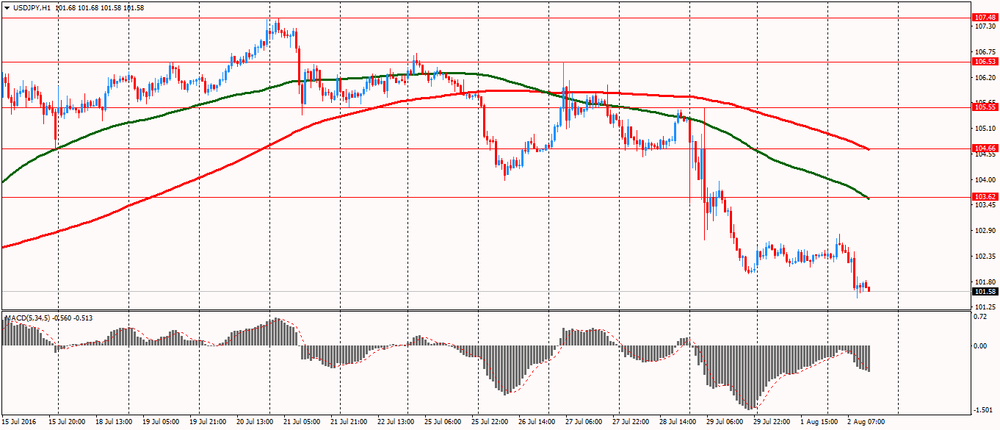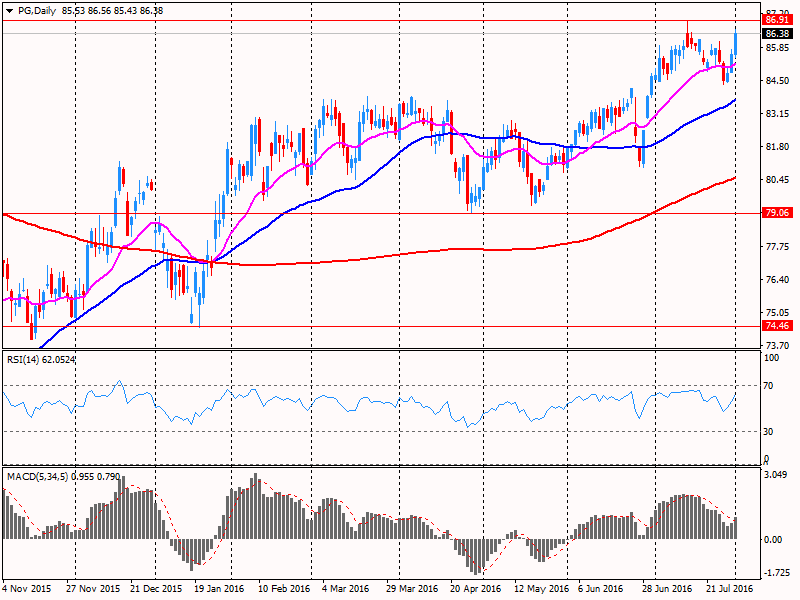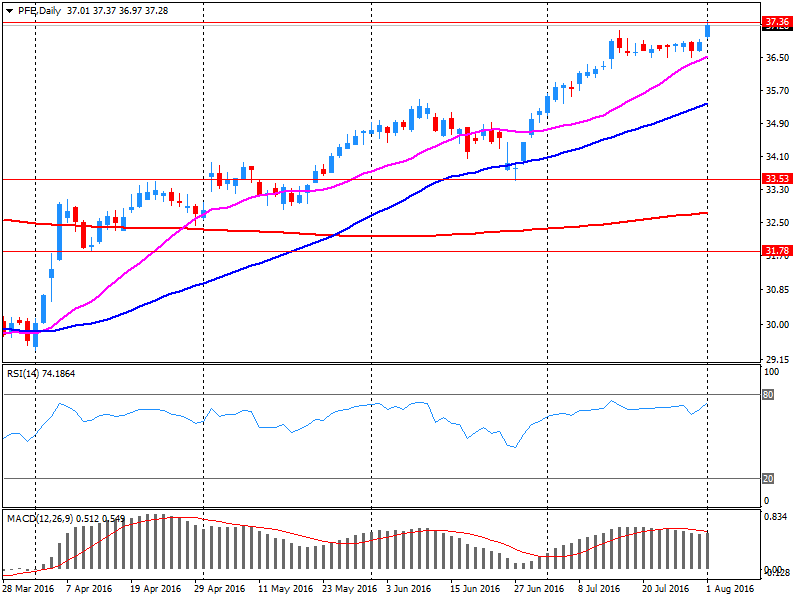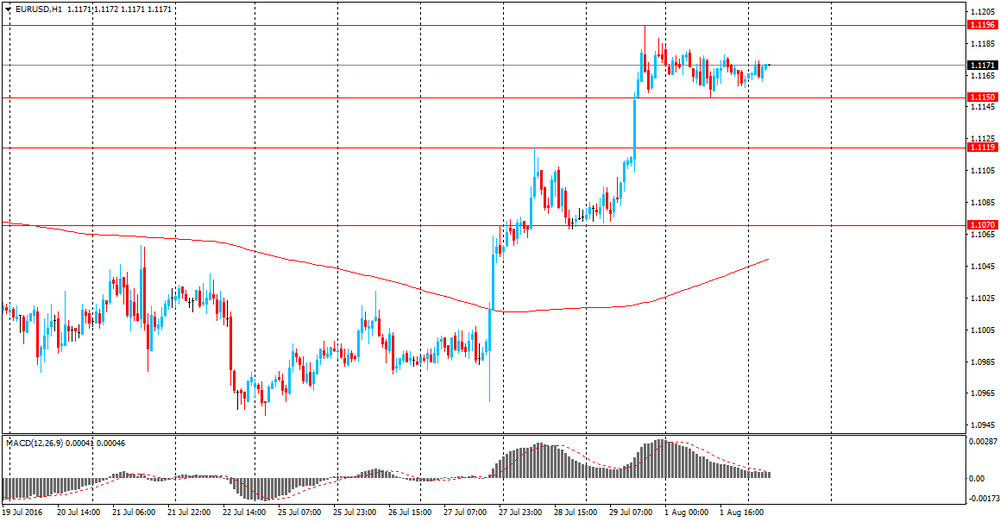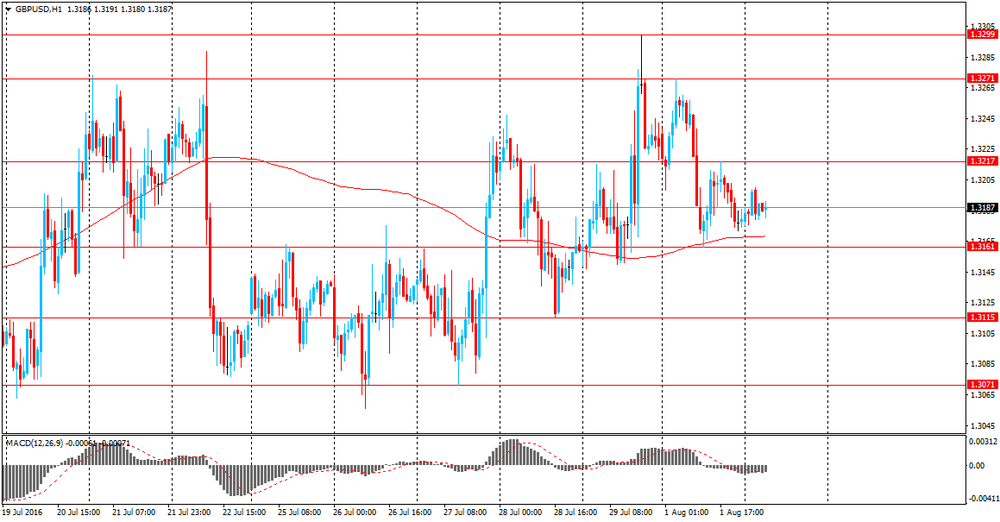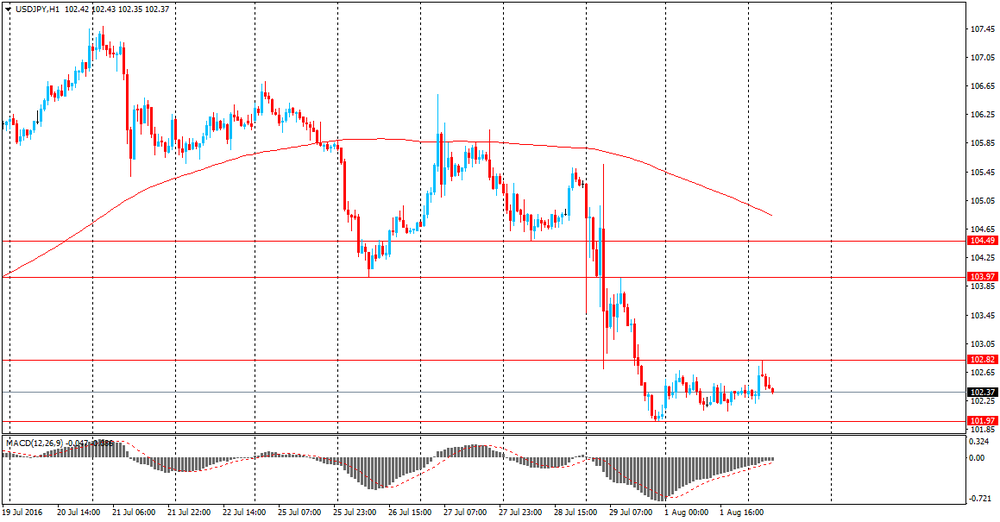Noticias del mercado
-
22:16
U.S.: Total Vehicle Sales, mln, July 17.88 (forecast 17.1)
-
22:07
Major US stock indexes finished trading below zero

Major US stock indexes fell on Tuesday after weak US economic data disappointed investors.
As it became known today, in June, personal income increased by $ 29.3 billion (0.2%) in June, according to estimates released today by the Bureau of Economic Analysis. Disposable personal income (DPI) increased $ 24.6 billion (0.2%), and personal consumption expenditures (the PCE) increased $ 53.0 billion (0.4%).
Real DPI increased by 0.1% in June and a real PCE increased 0.3%. PCE Price Index increased by 0.1%. With the exception of food and energy, PCE price index increased by 0.1%. The increase in personal income in June mainly reflects the growth of private incomes from wages and incomes of non-agricultural owners, which were partially offset by a decrease in personal income in the form of dividends and personal interest income.
Among the corporate nature of the posts should be noted quarterly reports Pfizer (PFE) and Procter & Gamble (PG). Quarterly results of both companies exceeded analysts' expectations. Pfizer's profit for the second quarter 2016 fingoda reached $ 0.64 per share, which is $ 0.02 higher than the average analyst forecast of $ 0.62. Quarterly revenue rose nearly 11%, to $ 13.147 billion., While the average forecast of analysts expected to increase to $ 13.013 billion. Shares of PFE fell, as the company left unchanged its forecast for the full 2016 fiscal year.
Procter & Gamble in the reporting period made a profit of $ 0.79 per share, which is $ 0.05 higher than the average market forecast. The company's revenue was $ 16,102,000,000., that turned out to be 2.7% per annum less, but 1.7% higher than the average forecast of analysts. The company also lowered its forecast for earnings per share figure for 2017 fiscal year to $ 3.67 against the analysts' forecast of $ 3.97 level.
Most components of the DOW index finished trading in negative territory (23 of 30). More rest up shares Exxon Mobil Corporation (XOM, + 1.06%). Outsider were shares of Pfizer Inc. (PFE, -2.20%).
Almost all sectors of the S & P closed in the red. the services sector fell the most (-1.2%). Maximizing showed conglomerates sector (+ 0.8%).
At the close:
Dow -0.49% 18,313.70 -90.81
Nasdaq -0.90% 5,137.73 -46.47
S & P -0.64% 2,157.03 -13.81
-
21:00
DJIA -0.59% 18,296.55 -107.96 Nasdaq -0.83% 5,141.07 -43.13 S&P -0.71% 2,155.43 -15.41
-
18:00
European stocks closed: FTSE 100 -48.55 6645.40 -0.73% DAX -186.18 10144.34 -1.80% CAC 40 -81.18 4327.99 -1.84%
-
17:46
Oil continues to decline
Oil prices rose more than 2 percent after falling by about $ 4 per barrel last week, but then went back into the red zone, as investors remain concerned about global oversupply.
Due to oversupply, Goldman Sachs note that in the near future should not expect the oil price recovery. "We expect that oil prices will remain in the area of $ 45 to $ 50 per barrel, at least until mid-2017, but it is necessary to take into account the existing risks".
"The market is continually focusing on oversupply, the bearish trend seems to be difficult to change in the near future", - said Hans van Cleef, ABN AMRO.
It is worth emphasizing that Brent oil futures fell nearly 21% from the highs reached in early June as expectations of increased exports from the Middle East and North Africa have raised concern that an excess of oil will reduce demand from refineries.
Some support was given from the weakening dollar, which potentially increases demand for oil, making it cheaper for buyers using other currencies.
Market participants are also waiting for data on US petroleum inventories. Later, a report of the American Petroleum Institute (API) will be published and official data from the Ministry of Energy will be known tomorrow. It is estimated that the Ministry of Energy reported that oil and gasoline declined last week to 1.75 million and 1 million barrels respectively, but nonetheless remained at very high levels for the current season.
The cost of the September futures on WTI fell to 39.92 dollars per barrel.
September futures price for North Sea petroleum mix of mark Brent fell to 41.55 dollars a barrel on the London Stock Exchange ICE Futures Europe.
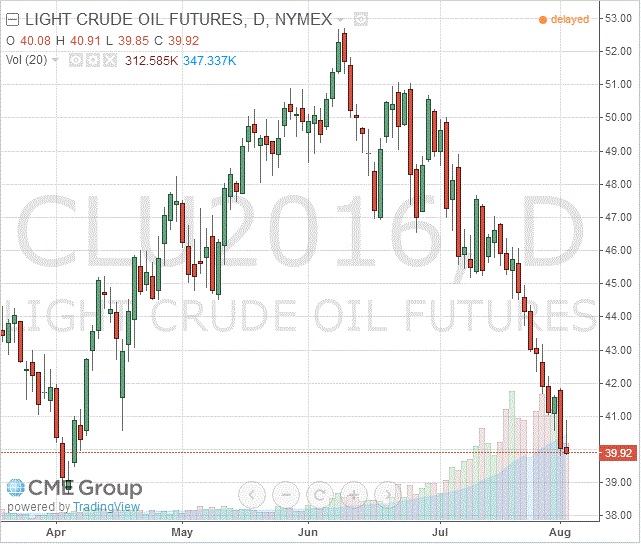
-
17:39
WSE: Session Results
Polish equity market closed higher on Tuesday, with the broad market measure, the WIG Index, surging by 1.75%. Sector performance within the WIG Index was mixed. Banking sector names (+6.35%) were the strongest group, supported by the announcement that the FX loans draft bill does not include forced re-domination of Swiss franc mortgages. At the same time, media stocks (-2.87%) and chemicals names (-2.49%) were the worst performers.
The large-cap companies' measure, the WIG30 Index, grew by 2.19%. In the index basket, all six constituents, belonging to the banking sector, generated strong returns with MILLENNIUM (WSE: MIL) outpacing with a 16.06% gain. On the other side of the ledger, media group CYFROWY POLSAT (WSE: CPS), property developer GTC (WSE: GTC), FMCG-wholesaler EUROCASH (WSE: EUR) and chemical producer GRUPA AZOTY (WSE: ATT) recorded the biggest drops, ranging between 3.36% and 3.93%.
-
17:28
The price of gold has increased today
The price of gold has increased by about 1 percent, helped by the dollar falling to a 6-week low against the euro.
Dollar continues to remain under pressure after the latest data on the US economy intensified investors' doubts the possibility of interest rates hikes by the Federal Reserve in the current year. The precious metal is sensitive to higher interest rates in the United States, but a gradual increase in rates carries less of a threat to the gold price than a series of hikes.
"People are concerned that US interest rates will not rise in the near future, and the stock market overheating further reinforces these concerns," - said ING analyst Hamza Khan.
US Federal Reserve officials expressed different views regarding the rate increase: Dallas Fed President Kaplan called for caution, while the president of the Federal Reserve Bank of San Francisco, Williams noted that the Fed could raise rates up to two times by the end of this year.
The rise in gold prices by 28 percent this year was largely due to a decrease of expectations that the Fed in the near future will continue to raise interest rates.
Gold reserves in the largest investment fund, SPDR Gold Trust, rose on Monday 8.9 tonnes, recording a maximum one-day inflow from the end of June.
The cost of the August gold futures on COMEX rose to $ 1365.00 per ounce.
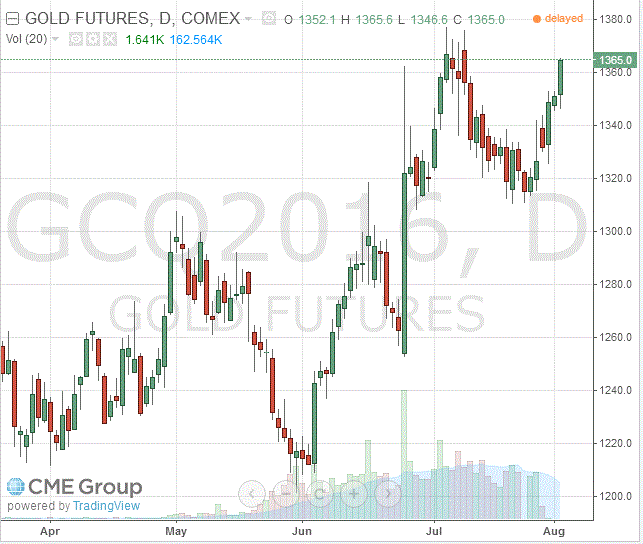
-
17:13
Wall Street. Major U.S. stock-indexes fell
Major U.S. stock-indexes lower on Tuesday after weak U.S. economic data disappointed investors. Data showed U.S. consumer spending rose more than expected in June as households bought a range of goods and services. However, core personal consumption expenditures (PCE), the Federal Reserve's preferred inflation measure, increased 1,6% in the 12 months through June, falling below the central bank's 2% target.
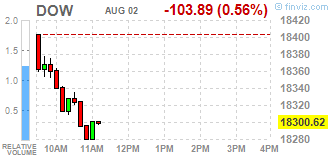
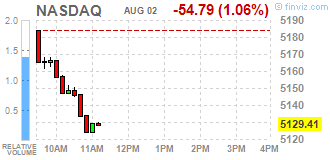
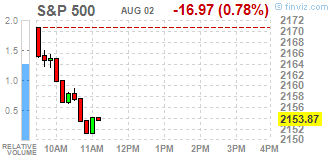
Almost all of Dow stocks in negative area (27 of 30). Top gainer - Exxon Mobil Corporation (XOM, +0.30%). Top looser - Pfizer Inc. (PFE, -2.52%).
All S&P sectors in negative area. Top looser - Services (-1.3%).
At the moment:
Dow 18221.00 -105.00 -0.57%
S&P 500 2147.25 -17.25 -0.80%
Nasdaq 100 4699.25 -45.25 -0.95%
Oil 40.11 +0.05 +0.12%
Gold 1373.00 +13.40 +0.99%
U.S. 10yr 1.54 +0.05
-
16:52
GlobalDairyTrade auction results
The price of dairy products increased by 6.6% after it remained unchanged at the previous auction. It is worth emphasizing the latter increase was the most significant since the beginning of October 2015.
Dairy products make up a significant proportion of New Zealand's exports, so the dynamics of their prices has a direct impact on the New Zealand dollar. After the announcement of the results of the auction a NZD / USD rose to 0.7231.
-
16:14
Canadian manufacturing output improves in July
Canadian manufacturers indicated another improvement in business conditions during July, underpinned by modest rises in output, new orders and employment levels. However, there were signs of weaker demand from export markets, as highlighted by a renewed drop in new work from abroad. Meanwhile, exchange rate depreciation against the U.S. dollar continued to push up overall input costs in July, with survey respondents citing higher steel prices in particular. The headline figure derived from the survey is the Markit Canada Manufacturing Purchasing Managers' Index™ (PMI™), which is designed to provide timely indications of changes in prevailing business conditions in the Canadian manufacturing sector. PMI readings above 50.0 signal an improvement in business conditions, while readings below 50.0 signal deterioration. At 51.9 in July, the seasonally adjusted Markit Canada Manufacturing PMI was up fractionally from 51.8 in June and above the neutral 50.0 value for the fifth consecutive month. This signalled a moderate improvement in overall business conditions, but the latest reading was still weaker than the average since the survey began in October 2010 (52.5).
-
15:53
WSE: After start on Wall Street
The market in the United States opened with a slight decrease and remains comfortably within the narrow consolidation lasting from mid-July. Traditionally, in such situations, investors are waiting for the impulse, however the conclusions drawn from the stabilization are positive, as the Wall Street defends itself against declines that prevail today in Europe or in part in Japan.
The Warsaw market today is in a great shape, but in a broader look a potential problem may be the environment. If the core markets, and with them a basket of emerging markets will settle a larger correction of recent weeks gains, the WIG20 might have a problem with self-shaping approach in a longer run.
-
15:49
Option expiries for today's 10:00 ET NY cut
AUD/USD 0.7370 (AUD 1.2bln) 0.7445-60 (760m) 0.7520 (1.1bln) 0.7570 (270m) 0.7600 (320m)
USD/CAD 1.3000 (USD 1.3bln)
-
15:35
U.S. Stocks open: Dow -0.02%, Nasdaq -0.10%, S&P -0.06%
-
15:34
Fed Kaplan: World production and consumption of oil will gain balance in the 1st half of 2017
- Oil prices will remain volatile until the end of the year
- Kaplan expects further bankruptcies, mergers and acquisitions in the energy sector in the current year
- Data on GDP for the 1st and 2nd quarter were disappointing
- Dallas Fed still expects GDP growth for the year as a whole at the level of 2% due to strong consumer demand
- Dallas Fed predicts decline in the proportion of economically active population to 61% by 2024
- I am sure that the general inflation will touch 2% in the medium term
- China's GDP growth is likely to slow
- It takes time to exert the influence of Brexit
- The stimulus should be reduced gradually and patiently
- The neutral rate decreased significantly over the last few years
- Reduced rates complicates the use of monetary policy
- Needed structural reforms and measures of fiscal policy to support economies
-
15:27
Before the bell: S&P futures -0.18%, NASDAQ futures -0.13%
U.S. stock-index futures declined as concern resurfaced about growth prospects with oil back in a bear market.
Global Stocks:
Nikkei 16,391.45 -244.32 -1.47%
Hang Seng 22,129.14 +237.77 +1.09%
Shanghai 2,971.28 +17.89 +0.61%
FTSE 6,693.95 -30.48 -0.45%
CAC 4,350.83 -58.34 -1.32%
DAX 10,330.52 -6.98 -0.07%
Crude $40.61 (+1.37%)
Gold $1370.60 (+0.81%)
-
14:59
Wall Street. Stocks before the bell
(company / ticker / price / change ($/%) / volume)
3M Co
MMM
178.15
-0.14(-0.0785%)
1032
ALCOA INC.
AA
10.49
0.02(0.191%)
18504
Amazon.com Inc., NASDAQ
AMZN
765.69
-2.05(-0.267%)
10323
Apple Inc.
AAPL
105.76
-0.29(-0.2735%)
117910
AT&T Inc
T
43.05
-0.13(-0.3011%)
3035
Barrick Gold Corporation, NYSE
ABX
22.51
0.28(1.2596%)
115046
Chevron Corp
CVX
99.5
0.39(0.3935%)
4403
Cisco Systems Inc
CSCO
30.84
0.11(0.358%)
4461
Citigroup Inc., NYSE
C
43.28
-0.14(-0.3224%)
18519
Deere & Company, NYSE
DE
77.1
-0.59(-0.7594%)
1510
Exxon Mobil Corp
XOM
86.25
0.39(0.4542%)
14659
Facebook, Inc.
FB
124.19
-0.12(-0.0965%)
40018
Ford Motor Co.
F
12.42
-0.06(-0.4808%)
71359
Freeport-McMoRan Copper & Gold Inc., NYSE
FCX
12.68
0.20(1.6026%)
85445
General Electric Co
GE
31.09
-0.06(-0.1926%)
12618
General Motors Company, NYSE
GM
31.2
-0.10(-0.3195%)
851
Goldman Sachs
GS
157.5
-0.68(-0.4299%)
3374
Google Inc.
GOOG
771
-1.88(-0.2432%)
1900
Hewlett-Packard Co.
HPQ
14.21
0.03(0.2116%)
2085
Johnson & Johnson
JNJ
125.48
0.08(0.0638%)
478
JPMorgan Chase and Co
JPM
63.58
-0.22(-0.3448%)
7250
Microsoft Corp
MSFT
56.64
0.06(0.106%)
11282
Nike
NKE
55.56
0.15(0.2707%)
330
Pfizer Inc
PFE
36.75
-0.56(-1.5009%)
173247
Procter & Gamble Co
PG
87.02
0.61(0.7059%)
328983
Starbucks Corporation, NASDAQ
SBUX
57.25
-0.18(-0.3134%)
1606
Tesla Motors, Inc., NASDAQ
TSLA
229.12
-0.89(-0.3869%)
16928
The Coca-Cola Co
KO
43.45
0.00(0.00%)
494
Twitter, Inc., NYSE
TWTR
16.56
-0.08(-0.4808%)
56969
Walt Disney Co
DIS
95
-0.54(-0.5652%)
2550
Yandex N.V., NASDAQ
YNDX
21.2
-0.06(-0.2822%)
4600
-
14:48
Upgrades and downgrades before the market open
Upgrades:
Downgrades:
Apple (AAPL) downgraded to Outperform from Buy at Daiwa
Other:
Barrick Gold (ABX) initiated with a Buy at Citigroup; target $29
Home Depot (HD) resumed with Buy ratings at Stifel
-
14:35
US: personal income rose 0.2% in June
Personal income increased $29.3 billion (0.2 percent) in June according to estimates released today by the Bureau of Economic Analysis. Disposable personal income (DPI) increased $24.6 billion (0.2 percent) and personal consumption expenditures (PCE) increased $53.0 billion (0.4 percent).
Real DPI increased 0.1 percent in June and Real PCE increased 0.3 percent. The PCE price index increased 0.1 percent. Excluding food and energy, the PCE price index increased 0.1 percent. The increase in personal income in June primarily reflected increases in private wages and salaries and nonfarm proprietors' income that were partly offset by decreases in personal dividend income and personal interest income.
-
14:30
U.S.: PCE price index ex food, energy, Y/Y, June 1.6%
-
14:30
U.S.: Personal spending , June 0.4% (forecast 0.3%)
-
14:30
U.S.: Personal Income, m/m, June 0.2% (forecast 0.3%)
-
14:30
U.S.: PCE price index ex food, energy, m/m, June 0.1% (forecast 0.1%)
-
14:29
European session review: US dollar fell against major currencies
The following data was published:
(Time / country / index / period / previous value / forecast)
Switzerland 7:15 Retail sales, y / y in June -1.7% -1.6% Revised to -3.9%
Switzerland 7:30 PMI in the manufacturing sector in July 51.6 51.7 50.1
8:30 UK index of business activity in the construction sector, m / m in July 46 43.8 45.9
9:00 Eurozone Producer Price Index m / m in June 0.6% 0.4% 0.7%
9:00 Eurozone Producer Price Index y / y in June -3.9% -3.5% -3.1%
The US dollar fell to a fresh five-week low against a basket of major currencies on Tuesday after reports of additional measures to stimulate the economy in Japan, while the lowered expectations of growth in the US putting pressure on the US currency before the end of the year.
The yen has strengthened the position after Japanese Prime Minister Shinzo Abe announced fresh stimulus to revitalize the Japanese economy.
The program includes 13.5 trillion yen of financial measures, of which about 7.5 trillion yen account for direct costs of stimulus measures over the next two years.
On Monday, the Institute for Supply Management said its index of business activity in the manufacturing sector fell to 52.6 last month from June's 53.2. Analysts had expected the index to decline in July to 53.0.
The pound rose against the dollar, despite the weak data on business activity in the construction sector. UK construction sector contracted less than expected in July, showed on Tuesday the results of a survey published by Markit.
Purchasing Managers' Index from Markit / Chartered Institute of Purchasing and Supply fell to 45.9 in July from 46.0 in June. According to forecasts, the index was expected to decline to 43.8.
The index has been below the neutral level of 50.0 for the second month in a row, reflecting a reduction in the sector.
The index signaled the fastest decline in production in the construction sector since June 2009. The companies said that the weaker order books continued to act as a brake on economic activity in July.
Uncertainty after the referendum on EU membership was the main factor that affected the business activity in July, especially in the sector of commercial construction, Markit said.
Respondents indicated increased risk aversion and reduced investment spending among customers, despite the large number of speculative inquiries in anticipation of lower charges, said Tim Moore, senior economist at Markit.
"While there is little evidence of an imminent turn in business conditions, environmental factors seem to soften the fall of the British business optimism among construction companies."
The euro rose against the US dollar, supported by data on producer prices. Eurozone producer prices rose for the second month in a row in June, according to Eurostat.
Industrial producer prices rose by 0.7 percent for the month in June, slightly faster than the 0.6 percent rise in May.
On an annual basis, producer prices fell at a slower pace of 3.1 percent in June, after falling 3.8 percent the previous month, which was revised from a 3.9 percent fall reported initially.
Excluding energy, producer prices rose by 0.2 percent for the month, while they fell by 1.0 percent from June 2015.
Energy prices fell by 8.7 percent annually in June, while they rose by 2.4 percent compared to the previous month.
EUR / USD: during the European session, the pair rose to $ 1.1208
GBP / USD: during the European session, the pair rose to $ 1.3254
USD / JPY: during the European session, the pair fell to Y101.44
-
14:07
A Spike Higher In EUR/USD and a Short Squeeze In GBP/USD? - Societe Generale
"The US economy is still trundling along at a 2%-ish rate, unable to deliver an investment-led acceleration but unlikely to see these weak figures persist as long as there is any slack left in the labour market. So the soggy data, combined with the sense that the global economy is still comfortably away from stalling speed, merely reinforce the pressure on investors to search for yield, wherever and whenever they can find it.
In that context it's hard to be bullish of the dollar, unfortunately. Yield support is absent, and CFTC positioning data show dollar longs being cautiously rebuilt, and the GDP data will go a long way towards keeping the Fed inactive through the presidential elections. Not a good mix. Beware, in particular, a short squeeze in GBP/USD and a spike higher in EUR/USD.
UK PMI and CBI data were dire, and we'll get more PMI figures at the start of the week. We'll get a rate cut and more asset purchases from the BOE as well. Sterling is doomed to fall. And yet...the market is geared up for MPC easing, braced for bad data and short sterling already" - efxnews.
-
13:15
Company News: Procter & Gamble (PG) Q4 results beat analysts’ expectations
Procter & Gamble reported Q4 FY 2016 earnings of $0.79 per share (versus $1.00 in Q4 FY 2015), beating analysts' consensus estimate of $0.74.
The company's quarterly revenues amounted to $16.102 bln (-2.7% y/y), beating analysts' consensus estimate of $15.832 bln.
PG rose to $86.42 (+0.01%) in pre-market trading.
-
13:02
WSE: Mid session comment
The first half of trading on the Warsaw Stock Exchange was a clear concentration on banks. Of the 10 most active companies in the market was 6 banks. The strongest gain values of Bank Millennium (WSE: MIL +13,7%) and GetinNoble (WSE: GTN +25,58%), as these banks are most involved in lending in Swiss francs.
In the mid-session the WIG20 index was at the level of 1,800 (+2,20%) points and with the turnover of over PLN 540 mln.
-
12:59
Major stock indexes in Europe show a negative trend
European stocks decline following stock prices of oil companies, and a number of banks shares continue to become cheaper on the weak results of the stress tests.
Also disappointing manufacturing data in China and the United States continued to weigh on market sentiment, while investors focus today on the next series of corporate reports.
Data released on Monday showed that the official index of business activity in China's manufacturing sector weakened in July to 49.9 from 50.0 in the previous month, compared to expectations for no change.
In addition, the US Institute for Supply Management reported that its index of business activity in the manufacturing sector fell last month to 52.6 from June's 53.2. Analysts had forecast a decline in the index to 53.0.
The composite index of the largest companies in the region Stoxx Europe 600 fell during trading on 1,4% - to 335.26 points.
Market attention this week is aimed at meeting the Bank of England, which will be held August 3-4. Experts consensus forecast provides for the reduction of the base interest rate of the British Central Bank to 0.25% from 0.5%.
Shares of Royal Dutch Shell fell during trading on 1,6%, BP by 0.8%.
Securities of British banks Barclays and Royal Bank of Scotland (RBS) fell by 3.2% and 3.3%.
According to the results of stress tests by the European Banking Authority, EBA, Barclays was among the laggards, while RBS would show one of the harshest deterioration of capital adequacy in the negative developments.
Price of Commerzbank shares fell by almost 8%. The cost of InterContinental Hotels Group shares rose during trading on 1,7%. The hotel chain has cut its net profit in January-June by 46%, to $ 200 million, to $ 838 million The company said to be confident in the forecasts for the remainder of the year.
German retailer Metro's shares were down 6.5% as the company reported a surprise loss in the third quarter, mainly related to the cost of the reorganization of its operations in the wholesale markets in Germany, Belgium and Italy.
Shares of the German manufacturer Infineon slowed down 4% after its profit and revenue fell short of forecasts due to falling demand in the power supply and control units of plastic cards.
Shares of Deutsche Lufthansa AG rose 0.4% after the German airline company reported a nearly 12% increase in profits for the first half year on year. However, the group warned that the second half will be more difficult and that it will continue to strive for cost reductions.
At the moment:
FTSE 6660.71 -33.24 -0.50%
DAX 10196.97 -133.55 -1.29%
CAC 4348.49 -60.68 -1.38%
-
12:59
Company News: Pfizer (PFE) Q2 results beat analysts’ expectations
Pfizer reported Q2 FY 2016 earnings of $0.64 per share (versus $0.56 in Q2 FY 2015), beating analysts' consensus estimate of $0.62.
The company's quarterly revenues amounted to $13.147 bln (+10.9% y/y), beating analysts' consensus estimate of $13.013 bln.
PFE rose to $37.60 (+0.78%) in pre-market trading.
-
12:08
MPC, Charlie Bean: BOE rate cut won't have a huge economic impact
-
Given the data post-Brexit, some sort of stimulus is warranted
-
Fiscal policy is key after the vote
-
Is surprised by the extent of the BOE steer on stimulus
-
Doesn't rule out joint action between the BOE and Treasury
*via forexlive
-
-
12:06
Switzerland: Retail sales continue to decline
Swiss retail sales continued to decline in June, data released by the Federal Statistical Office on Tuesday.
Retail sales declined by 3.9 percent year on year in June, faster than the decline of 1.7 percent recorded in May. In addition, the decline was larger than expected (- 2 percent).
On a monthly basis, retail trade turnover recorded a decline of 0.5 percent in June.
Except for service stations, retail sales fell 0.5 percent in May. Sales of food, drinks and tobacco fell by 0.7 percent and non-food sales were down 0.6 percent.
In nominal terms, the total turnover of retail trade decreased by 4.6 percent in June compared with the previous year. The decline continued in January 2015, and that was the biggest decline since January 2003, said the Bureau of Statistics.
In monthly terms, the nominal retail trade turnover fell by 3.9 per cent in June.
-
11:07
Euro Zone producer prices increased in June
In June 2016, compared with May 2016, industrial producer prices rose by 0.7% in the euro area (EA19) and by 0.8% in the EU28, according to estimates from Eurostat, the statistical office of the European Union. In May 2016 prices increased by 0.6% in both zones. In June 2016, compared with June 2015, industrial producer prices decreased by 3.1% in the euro area and by 2.9% in the EU28.
The 0.7% increase in industrial producer prices in total industry in the euro area in June 2016, compared with May 2016, is due to rises of 2.4% in the energy sector, of 0.3% for intermediate goods and of 0.1% for both capital goods and non-durable consumer goods, while prices remained stable for durable consumer goods. Prices in total industry excluding energy increased by 0.2%.
-
11:01
EUR/USD: Gains Unlikely Sustainable - BTMU
"USD: The US dollar weakened by 0.6% on a DXY index basis in July with all of that depreciation and some more coming on the final trading day of the month in response to weaker than expected real GDP data for Q2. Real GDP growth has now been very subdued for three quarters, averaging just 1.0% over that period, adding more uncertainty to the economic outlook. However, we expect better growth rates in Q3 and Q4 and for the Federal Reserve to raise the federal funds rate in December.
Risks are skewed to the downside for the dollar over the short-term with economic uncertainty reinforced by political uncertainty ahead of the presidential election on 8th November. While downside risks are evident we still expect the dollar to be broadly stable as weak growth abroad and central bank easing in response provides support for the dollar. Once the election has passed and the Fed lifts rates as economic and political uncertainties fade, the dollar is set to perform well.
EUR: The increased economic and political uncertainty in the US that is set to weigh on the US dollar is likely to result in continued stability for the EUR/USD rate.
There are now perhaps greater upside risks over the short-term given the euro-zone large current account surplus will add to the attraction of the euro in circumstances of increased uncertainty.
However, any gains for the euro are unlikely to be sustained given eurorelated risks may also intensify. Increasing episodes of terrorism ahead of key elections in France and Germany next year which follow the constitutional reform referendum in Italy in October mean scope for EUR appreciation is limited".
Copyright © 2016 BTMU, eFXnews™
-
11:01
Eurozone: Producer Price Index (YoY), June -3.1% (forecast -3.5%)
-
11:01
Eurozone: Producer Price Index, MoM , June 0.7% (forecast 0.4%)
-
10:40
Oil shows moderate gains
This morning, New York crude oil futures for WTI grew by 0.52% to $ 40.27 and crude oil futures for Brent rose by + 0.57% to $ 42.38 per barrel. Thus, the black gold has increased in anticipation of the release of data on trade in US oil inventories. According to economists, the US reserves of crude oil and gasoline fell in the last week 1.75 million and 1 million barrels respectively. However, the values remain at the highest marks for the current season in the last two decades.
-
10:38
UK's construction sector PMI below 50
July data signalled a further downturn in UK construction output, but the rate of contraction was only fractionally faster than that seen during the previous survey period. At the same time, new order volumes dropped at a slower pace than the three-and-a-half year low seen in June. Anecdotal evidence suggested that economic uncertainty following the EU referendum was the main factor weighing on business activity in July, especially in the commercial building sector.
However, there were also reports suggesting that demand patterns had been more resilient than expected, and some firms linked new enquiries from international clients to exchange rate depreciation. The seasonally adjusted Markit/CIPS UK Construction Purchasing Managers' Index registered 45.9 in July, down fractionally from 46.0 in June and below the 50.0 no-change threshold for the second month running. The latest reading signalled the fastest overall decline in construction output since June 2009. This largely reflected the steepest fall in commercial building for over six-and-a-half years, alongside a drop in civil engineering activity for the first time in 2016. Residential construction also declined at a solid pace in July, but the rate of contraction eased from June's three-and-a-half year low.
-
10:31
United Kingdom: PMI Construction, July 45.9 (forecast 43.8)
-
09:45
Major stock exchanges began trading lower: FTSE -0.2%, DAX -0.1%, CAC40 -0.3%, FTMIB -0.2%, IBEX -0.3%
-
09:30
Switzerland: Manufacturing PMI, July 50.1 (forecast 51.7)
-
09:28
Spanish employment continue to improve
The number of unemployed people registered at the offices of the Public Employment Services has dropped in July in 83,993 persons in relation to the previous month. This is the largest decline in July since 1997. Thus, the total number of registered unemployed stood at 3,683,061, the lowest since August 2009. During the last 8 years in this month, registered unemployment decreased by an average of 37,000 people. In seasonally adjusted terms, unemployment one month reduced by 48,573 persons in July. This is the largest reduction of the entire series in July.
-
09:12
WSE: After opening
WIG20 index opened at 1777.79 points (+0.89%)*
WIG 46700.67 1.04%
WIG30 2029.44 1.32%
mWIG40 3629.44 0.63%
*/ - change to previous close
The cash market (the WIG20 index) opens with a rise of 0.89% to 1,777 points, affected by the good attitude of banks, especially those with portfolios of CHF loans. Investors clearly believe in very mild currency loans Act, but it turns out that it will be after 11:00 (Warsaw time), when is scheduled to begin a press conference. The turnover is considerable, and attention for obvious reasons is focused on banks.
Behavior of the environment, or whether it is the core markets of Euroland or the emerging markets of the region, is for us a second-plan (if not even less) important.
-
09:12
Today’s events:
At 10:15 GMT FOMC member Robert Kaplan will deliver a speech
At 23:50 GMT the minutes of the Bank of Japan on monetary policy
-
09:04
Asian session review: The Australian dollar traded mixed
The Australian dollar fell sharply, reaching a minimum of $ 0.7480 after the Reserve Bank of Australia lowered its benchmark interest rate by 25 bps to 1.5%, but in the course of trading regained lost ground.
According to data published last week, in the second quarter, inflation fell to 1.5%, well below the central bank's target range of 2% -3%. RBA worry that low inflation can affect the mood of companies and households. According to the current forecast of the central bank, inflation returns to the target range until mid-2018.
In August 2013, the Australian central bank set the rate at 2.5% - this was the lowest level in the last 60 years. Nevertheless, due to the slowdown in economic growth the central bank decided to lower it again in February of last year to 2.25%, and three months later there was a new slide - to historically record low of 2%. In May of this year, the Central Bank, fearing the threat of deflation, lowered the rate to 1.75%, and today - another quarter percentage point.
The deficit of foreign trade of Australia rose sharply and amounted to AUD $ -3,2 billion from A $ -2.42 billion in May. Analysts had forecast a deficit of A $ -2,0 billion.
The trade balance - the indicator published by the Australian Bureau of Statistics, and assessing the ratio between exports and imports of goods. Export performance is an important indicator of the rate of growth of the Australian economy, while import indicates the level of domestic demand. Reduced demand for exports from Australia, leads to an increase in the trade deficit, which has a negative impact on the Australian dollar.
Export dropped in June 1.0% compared to a 1.0% increase in May.
Imports increased by 2.0% in June as in May.
Building permits, published by the Australian Bureau of Statistics, decreased by -2.9% in June, below analyst expectations of 0.5%. Previous value of the index was revised from -5.2% to -5.4%. The annual rate of building permits fell to -5.9%, -9.2% prior to the year after the fall.
Permits for the construction of private homes fell 2.3%. The construction of apartments in the private sector decreased by 2.4%
The New Zealand Dollar was down against the US dollar on the back of falling oil prices. Published today, the quarterly report of the Reserve Bank of New Zealand showed that inflation expectations have remained stable, but low in the third quarter. The expectations about the pace of growth in consumer prices in the 24 months ahead in the third quarter was 1.65% versus 1.64% in the second quarter. Inflation expectations for the next 12 months were equal to 1.26% against 1.22% in the previous quarter.
The US dollar traded in a narrow range against the euro after Friday showed widespread fall as weak data exacerbated concerns about economic growth and the increase in US Federal Reserve interest rates this year.
EUR / USD: during the Asian session, the pair was trading in the $ 1.1160-80 range
GBP / USD: during the Asian session, the pair was trading in the $ 1.3179-85 range
USD / JPY: during the Asian session, the pair was trading in Y102.00 - 102.05 range
-
08:35
Options levels on tuesday, August 2, 2016:
EUR/USD
Resistance levels (open interest**, contracts)
$1.1268 (3039)
$1.1236 (3367)
$1.1215 (2911)
Price at time of writing this review: $1.1176
Support levels (open interest**, contracts):
$1.1126 (1853)
$1.1089 (2917)
$1.1045 (3130)
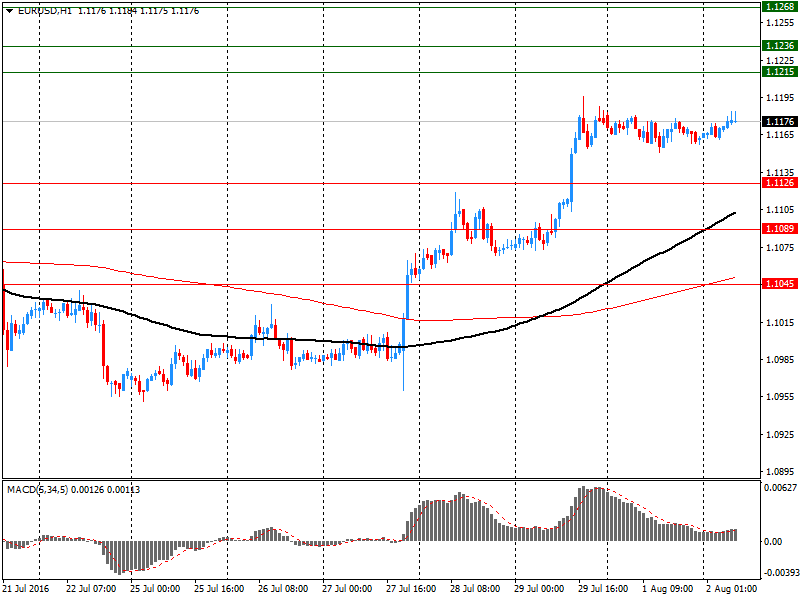
Comments:
- Overall open interest on the CALL options with the expiration date August, 5 is 39256 contracts, with the maximum number of contracts with strike price $1,1300 (3763);
- Overall open interest on the PUT options with the expiration date August, 5 is 52188 contracts, with the maximum number of contracts with strike price $1,0900 (6556);
- The ratio of PUT/CALL was 1.33 versus 1.31 from the previous trading day according to data from August, 1
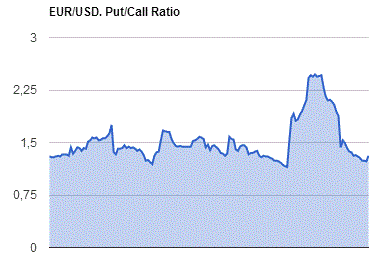
GBP/USD
Resistance levels (open interest**, contracts)
$1.3502 (1854)
$1.3403 (2006)
$1.3306 (1675)
Price at time of writing this review: $1.3188
Support levels (open interest**, contracts):
$1.3094 (2614)
$1.2997 (1951)
$1.2898 (852)
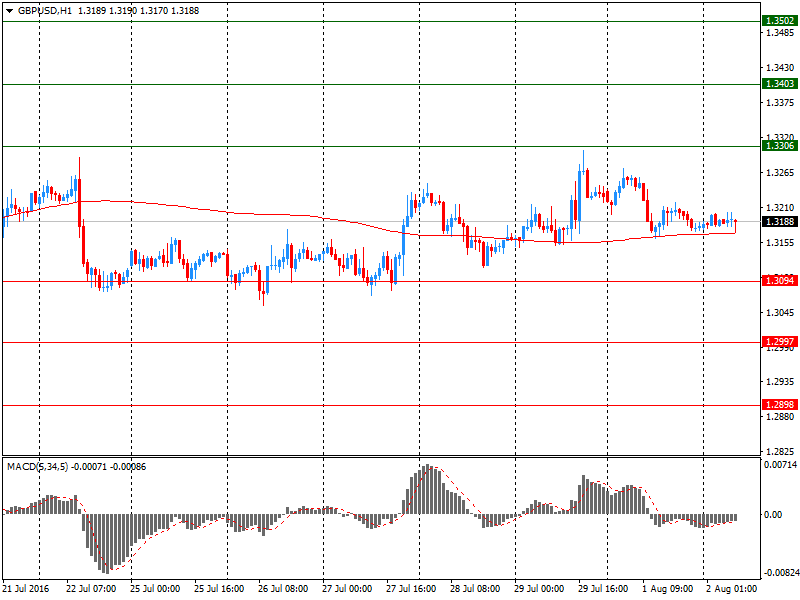
Comments:
- Overall open interest on the CALL options with the expiration date August, 5 is 27947 contracts, with the maximum number of contracts with strike price $1,3400 (2006);
- Overall open interest on the PUT options with the expiration date August, 5 is 26798 contracts, with the maximum number of contracts with strike price $1,2950 (3100);
- The ratio of PUT/CALL was 0.96 versus 0.93 from the previous trading day according to data from August, 1
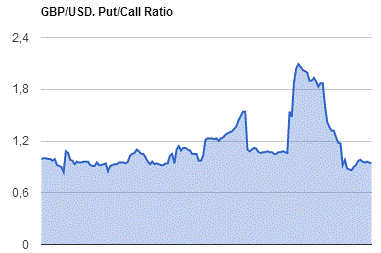
* - The Chicago Mercantile Exchange bulletin (CME) is used for the calculation.
** - Open interest takes into account the total number of option contracts that are open at the moment.
-
08:24
Building approvals in Australia down 2.9% in June
The number of dwellings approved fell 0.9 per cent in June 2016, in trend terms, according to data released by the Australian Bureau of Statistics (ABS) today. This is the second successive monthly fall.
Dwelling approvals decreased in June in Western Australia (5.2 per cent), Tasmania (3.7 per cent), Queensland (3.2 per cent), Australian Capital Territory (2.8 per cent) and Victoria (0.1 per cent), but increased in the Northern Territory (3.6 per cent), South Australia (1.6 per cent) and New South Wales (0.8 per cent) in trend terms.
In trend terms, approvals for private sector houses fell 0.6 per cent in June. Private sector house approvals fell in Western Australia (3.5 per cent), Victoria (0.6 per cent), Queensland (0.5 per cent) and South Australia (0.3 per cent). Private sector house approvals rose in New South Wales (0.9 per cent).
In seasonally adjusted terms, total dwelling approvals decreased 2.9 per cent, with both total other residential dwelling approvals (3.4 per cent) and total houses (2.4 per cent) recording falls.
The value of total building approved rose 1.2 per cent in June, in trend terms, and has risen for six months. The value of residential building rose 0.1 per cent while non-residential building rose 3.7 per cent.
-
08:21
WSE: Before opening
Yesterday's trading on Wall Street ended with a slight, expected, declines. Tuesday morning is quiet with greater volatility visible only in case of falling by 1,3% Nikkei. Trade in Hong Kong today practically does not take place due to a typhoon, and the other parquets are dominated by small changes similar to those observed ones. Thus we may say that yesterday the worst of all the major markets preserved Europe.
Investors' attention will focus today on the presentation of project of the currency loans Act prepared by the office of the President. According to "Rzeczpospolita" the Act will be less severe for banks due to the awareness of the risks around the European banking sector and the relatively good condition of the national institutions. If these reports are confirmed we may be witnessing the positive market reaction to the less severe form of the Act, which should support the PLN and national banks. On the broad market is worth to pay attention to the data of PPI from the Euro Zone and the readings from the United States about expenditures and revenues.
-
08:20
Expected negative start of trading on the major stock exchanges in Europe: DAX-0.3%, CAC40 -0.3%, FTSE -0.3%
-
08:20
The trade balance of Australia below expectations in June
The deficit of foreign trade of Australia rose sharply and amounted to AUD $ -3,2 billion from A $ -2.42 billion in May. Analysts had forecast a deficit of A $ -2,0 billion.
The trade balance - the indicator published by the Australian Bureau of Statistics, and assessing the ratio between exports and imports of goods. Export performance is an important indicator of the rate of growth of the Australian economy, while import indicates the level of domestic demand. Reduced demand for exports from Australia, leads to an increase in the trade deficit, which has a negative impact on the Australian dollar.
Export dropped in June 1.0% compared to a 1.0% increase in May.
Imports increased by 2.0% in June as in May.
-
08:13
Full statement by Glenn Stevens, RBA governor
"At its meeting today, the Board decided to lower the cash rate by 25 basis points to 1.50 per cent, effective 3 August 2016.
The global economy is continuing to grow, at a lower than average pace. Several advanced economies have recorded improved conditions over the past year, but conditions have become more difficult for a number of emerging market economies. Actions by Chinese policymakers are supporting the near-term growth outlook, but the underlying pace of China's growth appears to be moderating.
Commodity prices are above recent lows, but this follows very substantial declines over the past couple of years. Australia's terms of trade remain much lower than they had been in recent years.
Financial markets have continued to function effectively. Funding costs for high-quality borrowers remain low and, globally, monetary policy remains remarkably accommodative.
In Australia, recent data suggest that overall growth is continuing at a moderate pace, despite a very large decline in business investment. Other areas of domestic demand, as well as exports, have been expanding at a pace at or above trend. Labour market indicators continue to be somewhat mixed, but are consistent with a modest pace of expansion in employment in the near term.
Recent data confirm that inflation remains quite low. Given very subdued growth in labour costs and very low cost pressures elsewhere in the world, this is expected to remain the case for some time.
Low interest rates have been supporting domestic demand and the lower exchange rate since 2013 is helping the traded sector. Financial institutions are in a position to lend for worthwhile purposes. These factors are all assisting the economy to make the necessary economic adjustments, though an appreciating exchange rate could complicate this.
Supervisory measures have strengthened lending standards in the housing market. Separately, a number of lenders are also taking a more cautious attitude to lending in certain segments. The most recent information suggests that dwelling prices have been rising only moderately over the course of this year, with considerable supply of apartments scheduled to come on stream over the next couple of years, particularly in the eastern capital cities. Growth in lending for housing purposes has slowed a little this year. All this suggests that the likelihood of lower interest rates exacerbating risks in the housing market has diminished.
Taking all these considerations into account, the Board judged that prospects for sustainable growth in the economy, with inflation returning to target over time, would be improved by easing monetary policy at this meeting".
-
08:11
RBA cuts interest rate. AUD/USD little changed
Australia's central bank lowered its key interest rate for the first time in three months.
The board of the Reserve Bank of Australia governed by Glenn Stevens on Tuesday reduced the cash rate to 1.50 percent from 1.75 percent. The outcome of the meeting came in line with expectations.
The bank last slashed its rate by 25 basis points in May, which was the first reduction in a year.
The Board judged that prospects for sustainable growth in the economy, with inflation returning to target over time, would be improved by easing monetary policy at this meeting.
Low interest rates supported domestic demand and the lower exchange rate since 2013 helped the traded sector. Although these factors assisted the economy to make the necessary economic adjustments, an appreciating exchange rate could complicate this, the bank noted.
Policymakers said the likelihood of lower interest rates exacerbating risks in the housing market has diminished.
-
07:27
Global Stocks
European stocks declined on Monday, with bank shares losing steam following stress-test results for the industry, and as an update on eurozone manufacturing activity showed further slowing.
The stress tests were aimed at showing how much capital, or cushion against losses, banks would have left on their balance sheets in a severe downturn. Italian, Irish and Spanish banks put in the worst performances of the 51 firms tested.
Banks that suffered hits to their capital buffers in the test scenarios included Italy's UniCredit SpA, London-based Barclays PLC and German lender Deutsche Bank AG. UniCredit UCG, -9.40% and Barclays BARC, -2.04% BCS, -3.03% opened higher but since flipped lower, losing 9.4% and 2%, respectively. Deutsche Bank shares DBK, -2.56% DB, -2.75% also gave up gains, closing 1.8% lower.
U.S. stocks lost momentum to finish mostly lower Monday as crude-oil futures returned to bear-market territory and weaker-than-expected manufacturing data raised doubts about the strength of the economy.
The S&P 500 SPX, -0.13% shed 2.76 points, or 0.1%, to close at 2,170.84 after the large-cap gauge hit a record intraday high of 2,178.29.
The Dow Jones Industrial Average DJIA, -0.15% fell 27.73 points, or 0.2%, to close at 18,404.51.
However, the Nasdaq Composite Index COMP, +0.43% climbed 22.06 points, or 0.4%, to end at 5,184.20, boosted by appetite for tech giants, including a 1.8% jump in shares of Apple Inc. AAPL, +1.77%
Meanwhile, losses for crude CLU6, +0.17% snowballed, with the U.S. oil benchmark dropping almost 4% and at one point trading below the key $40 level amid worries about a supply glut and subdued demand. Crude oil is now off 21.8% from its peak of $51.23 a barrel hit in early June, signifying a bear market, or drop of at least 20% from a recent peak.
Asian shares slipped on Tuesday, taking their cues from a modestly lower day on Wall Street, while crude oil prices stabilized after their overnight tumble and the U.S. dollar edged higher.
Reserve Bank of Australia has cut its cash rate target to 1.5% from 1.75%
-
07:02
Japan: Consumer Confidence, July 42.3 (forecast 42.2)
-
06:30
Australia: Announcement of the RBA decision on the discount rate, 1.5% (forecast 1.5%)
-
03:31
Australia: Building Permits, m/m, June -2.9% (forecast 0.5%)
-
03:30
Australia: Trade Balance , June -3.19 (forecast -2)
-
00:35
Stocks. Daily history for Aug 01’2016:
(index / closing price / change items /% change)
Nikkei 22 16,635.77 +66.50 +0.40%
Shanghai Composite 2,953.39 -25.9534 -0.87%
S&P/ASX 200 5,587.39 +25.03 +0.45%
FTSE 100 6,693.95 -30.48 -0.45%
Xetra DAX 10,330.52 -6.98 -0.07%
CAC 40 4,409.17 -30.64 -0.69%
S&P 500 2,170.84 -2.76 -0.13%
Dow Jones 18,404.51 -27.73 -0.15%
-
00:34
Currencies. Daily history for Aug 01’2016:
(pare/closed(GMT +3)/change, %)
EUR/USD $1,1162 -0,12%
GBP/USD $1,3179 -0,36%
USD/CHF Chf0,9678 -0,15%
USD/JPY Y102,36 +0,29%
EUR/JPY Y114,26 +0,18%
GBP/JPY Y134,88 -0,06%
AUD/USD $0,7534 -0,86%
NZD/USD $0,7167 -0,54%
USD/CAD C$1,3127 +0,72%
-
00:01
Schedule for today, Tuesday, Aug 02’2016:
(time / country / index / period / previous value / forecast)
01:30 Australia Building Permits, m/m June -5.2% 0.5%
01:30 Australia Trade Balance June -2.22 -2
04:30 Australia Announcement of the RBA decision on the discount rate 1.75% 1.5%
04:30 Australia RBA Rate Statement
05:00 Japan Consumer Confidence July 41.8
07:15 Switzerland Retail Sales (MoM) June 0.2%
07:15 Switzerland Retail Sales Y/Y June -1.6%
07:30 Switzerland Manufacturing PMI July 51.6 51.4
08:30 United Kingdom PMI Construction July 46 43.8
09:00 Eurozone Producer Price Index, MoM June 0.6% 0.4%
09:00 Eurozone Producer Price Index (YoY) June -3.9% -3.5%
12:30 U.S. Personal Income, m/m June 0.2% 0.3%
12:30 U.S. Personal spending June 0.4% 0.4%
12:30 U.S. PCE price index ex food, energy, m/m June 0.2% 0.1%
12:30 U.S. PCE price index ex food, energy, Y/Y June 1.6%
20:00 U.S. Total Vehicle Sales, mln July 16.7
23:30 Australia AIG Services Index July 51.3
23:50 Japan Monetary Policy Meeting Minutes
-
